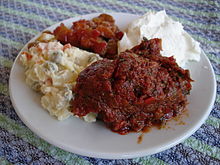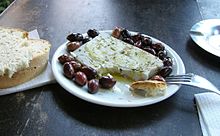Meze
This article needs additional citations for verification. (November 2007) |

Meze or mezze (Arabic, مَزة, Greek mezé (μεζέ), Bulgarian мезé mezé, Macedonian мéзе méze, from Turkish meze, ultimately from Persian maze (مزه) "taste, snack" [1][2]) in the Eastern Mediterranean is a selection of appetizers or small dishes often served with beverage, like anise-flavored liqueurs such as arak, ouzo, raki or different wines, similar to the tapas of Spain or finger food.
In Levantine cuisines and in the Caucasus region (especially in Armenia and Georgia), these dishes are served as appetizers, as a part of any large-scale meal.[3] When not accompanied by alcohol, meze is known in the Arab world as muqabbilat (Arabic for "starters").
Different types


In Turkey meze are served along with rakı (anise-flavored apéritif) in establishments called meyhane. Turkish meze often consist of beyaz peynir (literally "white cheese"), kavun (sliced ripe melon), acılı ezme (hot pepper paste often with walnuts), haydari (thick strained yoghurt like the Levantine labne), patlıcan salatası (cold aubergine salad), kalamar (calamari or squid), enginar (artichokes), cacık (yoghurt with cucumber and garlic), pilaki (various foods cooked in a special sauce), dolma or sarma (rice-stuffed vine leaves or other stuffed vegetables, such as bell peppers), and köfte (meatballs).

In Greece and Cyprus, meze, mezes, or mezethes are small dishes, hot or cold, spicy or savory, often salty (and/or a small portion of a main dish). Often seafood dishes are served as meze, such as "little fish" or grilled octopus, small salads, kalamata olives, fava beans, fried vegetables, melitzanosalata (eggplant salad), taramosalata (salted and cured carp or cod roe mixed with bread crumbs or mashed potato, lemon juice, vinegar and olive oil), nuts and dried fruits, fried or grilled cheeses called saganaki, and various fresh Greek sheep, goat or cow cheeses (such as feta, kasseri, kefalotyri, graviera, anthotyros, manouri, metsovone and mizithra). Other small dishes are bekri meze (a Greek meat stew), and meatballs like keftedes and soutzoukakia smyrneika. Meze is served in restaurants called mezedopolion, served to complement beverage, and in similar establishments known as tsipouradiko or ouzeri (a type of café that serves beverage, like ouzo or tsipouro). A Taverna or Estiatorio also offer a meze as an orektiko (appetiser). Hosts commonly serve mezethes to entertain their guests at small get-togethers. Krasomezethes (literally "winemeze") is a meze that goes well with wines. Ouzomezethes are meze that goes with ouzo.
In Lebanon and Cyprus, meze is often a meal in its own right. There are vegetarian, meat or fish mezes. Groups of dishes arrive at the table about 4 or 5 at a time (usually between five and ten different groups). There is a set pattern to the dishes, typically olives, tahini, salad and yoghurt will be followed by dishes with vegetables and eggs, then small meat or fish dishes alongside special accompaniments, and finally more substantial dishes such as whole fish or meat stews and grills. Different establishments will offer different dishes, their own specialities, but the pattern remains the same. Naturally the dishes served will reflect the seasons, for example in late autumn, snails will feature in a meat meze. As so much food is offered, it is not expected that every dish should be finished. People eat it together, serving each other etc. Eating a Cypriot meze is a social event.
In Serbia, meze can include cheese, kajmak (clotted cream), salami, smoked ham, kulen (flavoured sausage), various bread types, while in Bosnia and Herzegovina, meze normally includes hard and creamy cheeses, smetana sour cream, (locally known as kajmak or pavlaka), suho meso (dried salted, smoked beef), pickles and sudžuk (dry, spicy sausage)
Albanian-style meze platters typically include prosciutto ham, salami and brined cheese, accompanied with roasted bell peppers (capsicum) and/or green olives marinated in olive oil with garlic.
Other meze dishes
Popular meze dishes in Cyprus, Israel, Lebanon, the Palestinian territories, Jordan and Syria include:
- Mutabbal/Babaghanoush - eggplant (aubergine) mashed and mixed with various seasonings.
- Hummus - a dip or spread made from cooked, mashed chickpeas
- Hummus with meat (hummus bi'l-lahm)
- Kibbeh (İçli Köfte in Turkey) - dishes made of burghul, chopped meat, and spices
- Kibbe Nayye - burghul, chopped lamb meat, and spices
- Spicy lamb and beef sausages (maqaniq and sujuk)
- Fried cauliflower
- Whole roasted young birds
- Yoghurt
- Labneh - strained youghurt
- Shanklish - cow's milk or sheep's milk cheeses
- Muhammara - a hot pepper dip with ground walnuts, breadcrumbs, garlic, salt, lemon juice, and olive oil
- Pastirma - seasoned, air-dried cured beef meat
- Tabbouleh - bulgur, finely chopped parsley, mint, tomato, scallion, with lemon juice, olive oil and various seasonings
- Fattoush (Fatuş in southern Turkey) - salad made from several garden vegetables and toasted or fried pieces of pita bread
- Rocket salad (salatat jarjir)
- Artichoke salad
Popular mezes in Bulgaria:
- Lukanka- spicy sausage
- Soujouk - dry, spicy sausage
- Sirene (white brine cheese) prepared in various ways
- Shopska salad - made with tomatoes, cucumbers, onion, roasted peppers and sirene
See also
- Ajvar
- Banchan
- Tapas
- Dim Sum
- Cuisine of Albania
- Cuisine of Armenia
- Bosnian cuisine
- Bulgarian cuisine
- Cuisine of Cyprus
- Greek cuisine
- Greek Macedonian cuisine
- Iraqi cuisine
- Iranian cuisine
- Israeli cuisine
- Lebanese cuisine
- Palestinian cuisine
- Spanish cuisine
- Syrian cuisine
- Serbian cuisine
- Turkish cuisine
References
- ^ Merriam-Webster Online - definition of meze
- ^ Encarta Dictionary Online - definition of meze
- ^ Alan Davidson, The Oxford Companion to Food, Oxford University Press, 1999, pp. 500-501.
